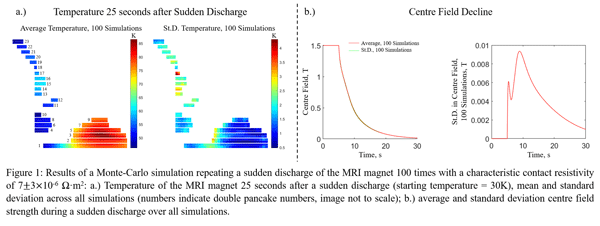AP6-4
Monte-Carlo Quench Analysis for an HTS NI Head MRI Magnet Undergoing Sudden Discharge
Dec.2 14:10-14:30 (Tokyo Time)
Robinson Research Institute, Victoria University of Wellington, Wellington, New Zealand1
Transpower Limited, Wellington, New Zealand2
A no-insulation (NI), cryogen-free HTS MRI magnet is under construction at the Robinson Research Institute. The magnet geometry is designed to accommodate a human brain inside the imaging volume. The magnet uses 23 double pancakes to create a moderately uniform (± 150 ppm) 1.5 T magnetic field over a 200 x 150 mm ellipsoidal imaging volume and will be used with MRI pulse sequences designed for low field uniformity.
To enable rapid emergency shutdown of the magnet, we have targeted a 20-second rapid discharge capability. The primary free parameter to tune discharge time is the turn-turn contact resistivity, which in turn affects quench risk, quench behaviour and the associated voltages and temperature changes. A detailed analysis of the multi-physics behaviour of the magnet during sudden discharge will help determine the optimum contact resistivity.
A lumped-circuit model was developed to predict the multi-physics behaviour of the MRI magnet during a sudden discharge, where the magnet geometry was divided into approximately 5 mm radial segments, with each coil segment modelled as an inductor with variable resistance in series and contact resistance in parallel. Each coil segment was permitted to have unique properties so that the effect of variability in the HTS tape material properties and contact resistivity during coil manufacture could be revealed. The Monte-Carlo technique was employed to further study variability, enabling the coil segment properties to be randomly chosen within realistic bounds and repeating the simulation many times.
This analysis reveals that a characteristic contact resistivity of 7x10-6 Ω·m2 achieves a centre-field of <0.05T 20 seconds after discharge. Repeating the simulation 100 times with a randomised coil segment variability of 3x10-6 Ω·m2 introduces a negligible variability in the rate of field decline, although this simultaneously introduced a larger degree of variability in the temperature profile of the magnet after discharge.
Keywords: Monte-Carlo simulation, Contact resistivity, Sudden discharge, No-insulation coils
